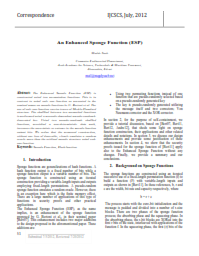Volume 9, 2019
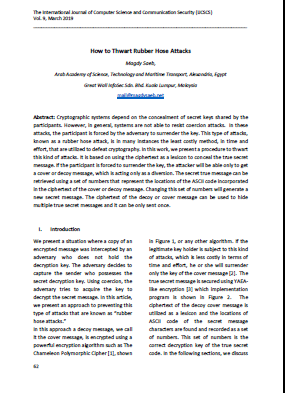
How to Thwart Rubber Hose Attacks
Magdy Saeb
March 2019
Abstract: Cryptographic systems depend on the concealment of secret keys shared by the participants. However, in general, systems are not able to resist coercion attacks. In these attacks, the participant is forced by the adversary to surrender the key. This type of attacks, known as a rubber hose attack, is in many instances the least costly method, in time and effort, that are utilized to defeat cryptography. In this work, we present a procedure to thwart this kind of attacks. It is based on using the ciphertext as a lexicon to conceal the true secret message. If the participant is forced to surrender the key, the attacker will be able only to get a cover or decoy message, which is acting only as a diversion. The secret true message can be retrieved using a set of numbers that represent the locations of the ASCII code incorporated in the ciphertext of the cover or decoy message. Changing this set of numbers will generate a new secret message. The ciphertext of the decoy or cover message can be used to hide multiple true secret messages and it can be only sent once.
Key Words: Cryptography, Key, Rubber Hose, Attacks, Thwart, Foil
https://ijcscs.org/wp-content/uploads/2019/09/rubberhosethwart-1.pdf
Volume 8, 2018
A Multi-Scale Best Basis Sparse Learning Framework for Efficient IoT Big Data Applications
Rami Zewail, Ahmed Hag ElSafi
July 2018
Abstract: With the emergence of the Internet of Things (IoT) and cheap wireless sensors networks, IoT telemetry has received much interest over a wide range of fields including industrial applications and machine monitoring, telemedicine, and wearables. In the era of Big Data, there has been an ever-growing demand for efficient modeling and analyzing of high resolution and large-scale volumes of data. In response to these challenges, efficient signal representation has been drawing much attention lately within the research community. Concepts of sparse representation and compressed Sensing are emerging techniques that have great potentials to meet some of the challenges faced by IoT and Big Data such as device power consumption, data redundancy, bandwidth, and data storage and transmission. In this paper, we present a novel Multi-Scale Adaptive sparse learning framework for efficient signal IoT BIG DATA applications. Given a test set of the signal of interest, an adaptive dictionary learning process is proposed for sparse and redundant signal representation. First, a Joint-best basis representation is learned in the wavelet packet domain that is optimized for the class of signals of interest. Next, dictionary learning is performed in the wavelet packet domain. The proposed framework enjoys the merits of being adaptable, efficient, and easy to deploy. The proposed framework allows for the extract of an optimal sparse representation for the signals of interest while preserving the discriminatory characteristics. Experimental results are presented to evaluate the performance of the new framework using a wide range of signals including faulty machinery vibration signals, ECG signals, Surface Myoelectric signals, and seismic gamma-ray signals.
Keywords: Internet of Things, Big Data, sparsity, dictionary learning
Volume 6, 2016
Number 3, March 2016
A One-pass Key Distribution Protocol Based on the Hamming Code
Magdy Saeb
March 2016
Abstract: Encryption key distribution is a fundamental cryptographic research area. In this work, we present a one-pass key distribution protocol utilizing the Hamming Error Detection and Correction Code. The shared secret is a random string of bits. For high-security applications, this shared secret can be changed for generating a new key. For other types of applications, we show that this step is nonobligatory since the bit string is partially updated every time a new key is generated. Additionally, the Strict Avalanche Criteria (SAC) of any hash function design results in a change of 50% of the output bits for a one-bit change in the input to the hash function. Therefore, the shared secret is acquired only one time as an initial value (IV). It also serves as an authentication vehicle. The proposed technique uses simple arithmetic and logic operations that provide uncomplicated and efficient software and hardware implementations.
Keywords: Key Distribution, Hamming Code, Error Detection, Error Correction, Cryptography, Authentication, Encryption.
Number 2, February 2016
Correspondence
Reduction of Encryption Key search Based on The Min-Entropy Approach
Magdy Saeb, Feb. 2016
Abstract: Encryption key search is basically guessing the value of a random variable X by trials of the form “Is X equal to x?” until the correct value is found. We show how to reduce the search space from 2^n for a brute force attack or 2^n/2 for a Birth Day Attack to a smaller number of trials less 2^n/2 where n is the number of key bits. This is accomplished using the fact that the internally generated keys, by design, have a ratio of the number of ones approximately ranging from 0.45 to 0.499 to maximize the key entropy H. Using this simple observation, the search range is reduced from O (2^n/2) to O (2^D), where D is the range specified by min-entropy for key guessing with added available information to the adversary.
Key words: key, search, cipher, min-entropy, search space, key guessing.
Number 1, January 2016:
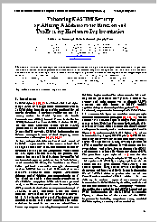
Enhancing Kasumi by Affixing a Metamorphic Function and The Ensuing Hardware Implementation
R. Mahmoud, A. Baith, M. Saeb
January, 2016
Abstract: To enhance the security of the well-known KASUMI Cipher, we apply a Metamorphic Feistel Structure. The proposed structure uses four bit-balanced operations in the function FO of the KASUMI Cipher. These operations are: XOR, INV, ROR, and NOP for bitwise XOR, invert, rotate right, and no operation respectively. The operations constitute the building blocks of the Crypto Logic Unit (CLU). In the second KASUMI Metamorphic modification, another Generalized Crypto Logic Unit (GCLU) is utilized. In addition to the four bit-balanced CLU operations, the GCLU utilizes XNOR, SWAP, ROL, and RevOr for bitwise XNOR, swap, left rotation, and reverse order operations respectively. In this work, we present the Metamorphic-KASUMI Cipher, and the Generalized-Metamorphic-KASUMI Cipher. In addition, we provide a Field Programmable Gate Array (FPGA) implementation of the two proposed algorithm modifications.
Keywords: Metamorphic, KASUMI, Cipher, FPGA.
Volume 5, 2015
Number 4, August 2015:
Correspondence
Security Analysis of the Power Based Key Hopping (PBKH) Technique
Magdy Saeb
August 2015
Abstract: In a previous work, we showed that Key Hopping based on packet or message power (PBKH) tremendously increases the keyspace and consequently the cipher security. In the present work, we provide security analysis of this technique computing the required minimum times, in computer cycles, to break all or one of the sequence keys.
Keywords: Cipher, Key, Hopping, Power-based, Sequence Key
Security Analysis of the Power Based Key Hopping Technique 1
Number 3, July 2015
Metamorphic Feistel Networks
Magdy Saeb
July, 2015
Abstract: In classical Feistel Networks, a one-way function (F) is using the round key as an input parameter tochange its output. However, in this work, the round key serves two roles; it changes the structure, or morphs the one-way function rendering it a metamorphic one-way function (MF) and at the same time encrypts the right hand side of the Feistel Network using this function. We discuss this concept and show the resulting generalized modified structures for various Feistel Networks.
Key words: Feistel Network, Metamorphic, Cipher, Encryption
Number 2, February 2015:
Correspondence
Encryption key Distribution Applying Key Embedding and Environmental Initiation
Magdy Saeb
February 2015
Abstract: In this approach, we utilize the transmitted encrypted file as a modulated channel that carry the decryption key of the succeeding file. We initialize the procedure employing an environmental random string. The procedure deployed is very similar to a linked list data structure where the data part is the encrypted file and the embedded key, for decrypting the consecutive cipher, is the address part.
Keywords: Key, Distribution, Encryption, Cipher, Pseudorandom, Linked List, Data Structure.
Number 1, January 2015
Hardware Implementation of Binary Kolakoski Sequence
Rabie A. Mahmoud
January, 2015
Abstract: Kolakoski Unit (KU) is a simple structure designed to implement the binary form of Dekking substitutions which are used to generate the binary form of the infinite Kolakoski sequence. This Kolakoski Unit uses one OR gate, one AND gate, and two Tri-state buffers. In addition, we provide Field Programmable Gate Array (FPGA) implementation of generationg the first 128-bit of binary Kolakoski sequence.
Volume 4, 2014
Number 6, October 2014
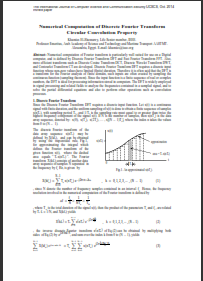
Invited paper
Numerical Computation of Discrete Fourier Transform Circular Convolution Property
Khamies El-Shennawy, Life Senior member, IEEE., 2014
Abstract: Numerical computation of Fourier transform is particularly well suited for use on a Digital computer, and is defined by Discrete Fourier Transform DFT and Fast Fourier Transform FFT. Also, more efficient transforms such as Discrete Cosine Transform DCT, Discrete Wavelet Transform DWT, and Contourlet Transform CT are developed. Discrete Fourier Transform DFT requires a discrete input function whose non-zero values have limited (finite) duration. Therefore it is often said that the DFT is a transform for the Fourier analysis of finite domain, such inputs are often created by sampling the continuous function (sampling theorem). Since the input function is a finite sequence of real or complex numbers, the DFT is ideal for processing information stored in computers. The DFT is widely employed in signal processing and related fields to analyze the frequencies contained in a sampled signal, and to solve the partial differential equations and also to perform other operations such as convolution processes.
Keywords: Discrete Fourier Transform
Number 5, September 2014
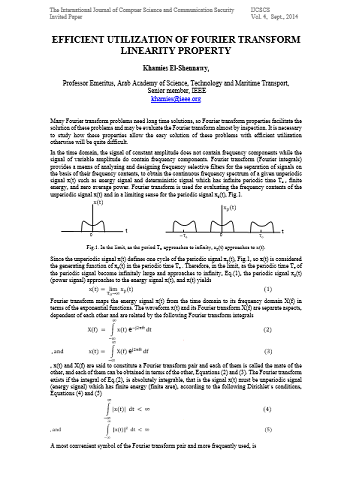
Invited paper
Efficient Utilization of Fourier Transform
Khamies El-Shennawy, Life Senior member, IEEE.,2014
Abstract:
Fourier transform problems need long-term solutions, so the Fourier transform properties facilitate the solution of these problems and is evaluated almost by inspection. It is necessary to study how these properties allow the easy solution of these problems with efficient utilization otherwise, it will be quite difficult.
Number 4, August 2014:
Encryption Key Distribution Applying Steganographic Techniques
Magdy Saeb
August, 2014
Abstract: The quondam problem of key distribution for symmetric ciphers has been, and still is, an essential element of secure information communications. In this proposed technique, we use ideas originated from steganography to hide the encryption key in the transmitted cipher text itself. The method begins by dividing the encryption key into an agreed-upon number of sub-keys. These sub-keys are concealed in the cipher text using a set of locations, known only to the sender and the receiver, as a shared secret. Then one transmits the resulting slightly longer message to the receiver where he or she can retrieve the key and decrypt the original message. We conjecture that since the ciphertext is a set of pseudorandom bits, embedding the pseudorandom bits representing the key will not be traceable. The proposed approach is suitable for both software and hardware implementations.
Key words: Cryptography, Encryption, Key distribution, Steganography.
Encryption Key Distribution Applying Steganographic Techniques1
Number 3, May 2014:
Computational Study of Fundamental Frequency of Standard Yorùbá Bi-Syllabic Vocalizations
Michael Adébísí Fáyẹ̀míwò and Ọdẹ́túnjí Àjàdí Ọdẹ́jọbí
May, 2014
Abstract This paper presents the development and evaluation of a computational model for the fundamental frequency (F0) of Standard Yorùbá (SY) bi-syllabic vocalizations. This was done with a view to approximating the F0 curves on SY syllables in the context of speech applications and other speech technologies. A list of 117 SY syllables which are the most frequently occurring syllables in Yorùbá newspapers and textbooks was compiled and the speech sound corresponding to the selected SY syllables were recorded for 5 adult native male speakers of SY. The F0 of the speech data were extracted using Praat speech processing package. Thereafter, Least Square Method (using polynomial degree of 1 to 7) was used to design the computational model for the F0 patterns extracted. The computational model was evaluated using the qualitative technique.The results of the model showed that polynomials starting with degree 4 gave a good approximation for bi-syllabic vocalizations.The study thereafter established the computational and perceptual correlations between the F0 curves and the three Yorùbá tones (High, Mid and Low) for SY bi-syllabic vocalizations. The modeling of F0 contour for Yorùbá tones for words and continuous speech are the areas of further research works, in which the principle of this work could be extended.
Keywords:Fundamental Frequency; Standard Yorùbá; Yorùbá tones; F0 curves; Synthesizing F0 pattern.
Number 2, April 2014:
Botnet Detection Techniques
Jihan Barazi, Ahmed Jaklan, Wang XiaoWei
April, 2014
ABSTRACT: Botnet detection and response is currently an arms race. The bot-masters rapidly evolve their botnet propagation and command and control technologies to evade the latest detection and response techniques from security researchers. Researches in botnets in addition to botnet detection include also Tracking, Measurement, Prediction, and Countermeasure. In this study, we try to raise main points in the field of botnet detection techniques.
Keywords: Botnet, Botnet detection, Network Security.
Number 1, March 2014:
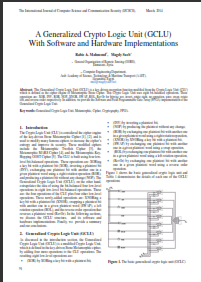
Generalized Crypto-Logic Unit
Rabie A. Mahmoud, Magdy Saeb
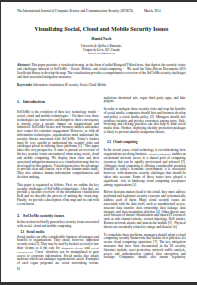
Visualizing Social Mobile Security Issues
Mob Web Services
Deepak Kapgate, Monali Khune
March, 2014
Absract: This paper presents an experiment relative to the use of short message application protocol (SMAP) to provide framework for mobile applications accessing Web Services. Here author refer to the most common architecture used to invoke Web Services, where a client and a server exchange short message application protocol (SMAP) messages provided by short message service (SMS) technology.To guarantee the independence of the application from the type of communication channel used, the paper deals with the problem of designing a framework allowing a Java application to directly interface Web Services from a mobile device using a short message application protocol (SMAP). In this system author has developed an application server called SMS server to accept end user information via short message service (SMS), access that information for user from internet and send it back in form of short message service (SMS) messages. Application server is connected to internet to access user data and send this information to end user’s mobile phone. Sending and receiving short message application protocol (SMAP) is done by SMS server.
Keywords: GSM modem, AT commands, smart phone, short message service (SMS), web service, short message application protocol (SMAP).
Improved Round Robin for data Centers
Deepak Kapgate
March, 2014
Abstract: In cloud computing, the main factor to achieve a high user satisfaction and increased resource utilization ratio by ensuring an efficient and fair allocation of every computing resource is effective load balancing. It helps to achieve. Proper load balancing aids in minimizing resource consumption, implementing failover, enabling scalability, avoiding bottlenecks etc. In Cloud Computing Scenario Load Balancing is composed of selecting Data Center for upcoming request and Virtual machine management of the individual Data Center. In this paper, we propose and implement an Improved Round Robin service broker (DC selection) algorithm in cloud computing. In addition, we compare the results of the proposed algorithm with existing algorithms. This study concludes that the proposed DC selection algorithm mainly focuses on reducing service response time observed at client side. The result shows a drastic reduction in Response time on the client side by using Improved Round Robin DC selection algorithm. Various parameters are also identified, and these are used to compare the existing techniques.
Keywords: Cloud Computing, Response time, Data Center Selection Algorithm, Service Broker Policy.
Improved_Round_Robin_Algorithm_for_Data_Center_Selection_in_Cloud_Computing
| Volume 3, 2013 |
| Number 7, October 2013:
A Metamorphic-Key-Hopping GOST Cipher and FPGA Implementation Rabie A. Mahmoud, Magdy Saeb Abstract: The Metamorphic-Key-Hopping GOST Cipher is a metamorphic cipher with a key hopping technique applying a function that uses four bit-balanced operations. It utilizes a key hopping that depends on the packet power t to alternate the keys. The function operations depend on what is known as the Crypto Logic Unit (CLU). These operations are: XOR, INV, ROR, NOP for bitwise xor, invert, rotate right and no operation respectively. The key hopping technique is called Power Based Key Hopping (PBKH). The Crypto logic unit replaces the adder CM2, previously used in the well-known GOST Cipher, and the power based key hopping replaces the key scheduling process. In this work, we present the Metamorphic-Key-Hopping GOST Cipher. In addition, we provide a Field Programmable Gate Array (FPGA) implementation of the modified algorithm Keywords: Metamorphic, GOST, Cipher, Power Based Key Hopping, Cryptography, FPGA. |
Number 6, September 2013:
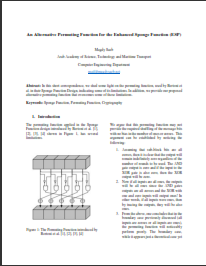
Abstract: In this short correspondence, we shed some light on the permuting function, used by Bertoni et al. in their Sponge Function Design, indicating some of its limitations. In addition, we provide our proposed alternative permuting function that overcomes some of these limitations.
Keywords: Sponge Function, Permuting Function, Cryptography
EnhancedSpongeFunctionFinalIJCSCS
Number 5, August 2013:

Abstract: With the different sources of threats to the Networks, from the physical and human threats to the extreme diverse methods used by hackers to exploit networks and disseminate different types of malware from simple kinds of comic, propaganda, ads, and viruses to highly sophisticated with a very advanced levels of Obfuscation Techniques like Packers, Polymorphism, Metamorphism [1] it’s becoming more and more difficult the task entrusted to network security scientists and engineers. Many kinds and different names of security monitoring and analysis tools have been used to detect the penetration on the networks and analyze the effectiveness of the network. The list is too long but we may mention Antivirus, firewalls, log audit tools, Host-based and Network-based Intrusion Detection Systems IDS, Low and High interaction based honeypots, general purpose and special purpose honeypots, network flow analysis tools,etc. It is too difficult for network security engineers to be aware of the huget of data produced by these different tools,e same time it has been proved that depending on one kind of these tools is not enough to protect the network from being exploited. In 1999 Bass Tim [2, 3] was the first author who recommended the application of Situational Awareness in the future Network Security. He foresees that next generation cyberspace intrusion detection systems will fuse data from heterogeneous distributed network sensors to create cyberspace situational awareness. In this paper we summarize the state of the art in situational awareness and its application in Network security, we will mention the different efforts done by scientists to apply the concept of Situational Awareness SA in network security.
Keywords: Network Security, Situational Awareness
Number 4, July 2013:
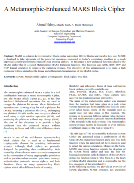
Number 3, April 2013:
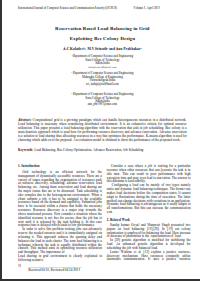
Number 2, February 2013:
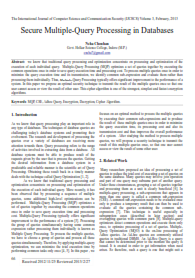
Abstract: We know that traditional query processing and optimization concentrate on processing and optimization of the execution of each individual query. Multiple-Query Processing (MQP) optimizes a set of queries together by executing thecommon operations once in order to save query execution time and processing cost. To process multiple queries once in order tominimize the query execution time and its transmission, we identify common sub-expression and evaluate them rather thanprocessing them individually. Thus, Multiple-Query Processing typically offers significant improvement to the performance of asystem. In this paper we propose an optimal security technique to transmit the result of the multiple queries once so that oneuser cannot access or view the result of other user. This cipher algorithm is one of the strongest, simplest and fastest encryptionalgorithms.
Keywords: MQP, CSE, Adhoc Query, Encryption, Decryption, Cipher Algorithm.
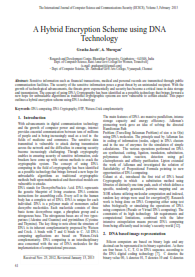
Abstract: Sensitive information such as financial transactions, medical and personal records are transmitted through public communication facilities. The security of the sensitive information poses a great threat by an unintended recipient. With the growth of technological advancements, the threats grow exponentially and security has become a critical issue in data storage and transmission. The concept of using DNA Cryptography has been identified as a possible technology that brings forward a new hope for unbreakable algorithms as traditional cryptographic systems are now vulnerable to certain attacks. This paper outlines a hybrid encryption scheme using DNA technology.
Keywords: DNA computing, DNA Cryptography, OTP, Watson-Crick complementarity
Number 1, January 2013:
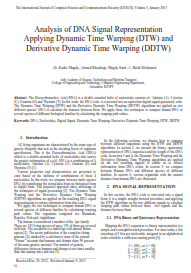
| Volume 2, 2012 |
| Number 4, July 2012:
An Enhanced Sponge Function (ESP)
Magdy Saeb
July, 2012
Abstract: The Enhanced Sponge Function (ESP) is constructed using two permutation functions. This is in contrast to using only one function as presented in the seminal paper on sponge functions by G. Bertoni et al. The use of only one function carries traces of Merkle-Damgard structure. The shuffling between two permuting functions is performed using a message-dependent pseudo-randomly generated key. Using two pseudo-randomly shuffled functions, providing a non-deterministic data path, increases the uncertainty or entropy in the sponge function output bits. We argue that the proposed construction, without any loss of generality, closely emulates a random oracle more than the original sponge structure using only one function.
Keywords: Sponge Function, Hash function, Cryptography
|
Number 3, March 2012:

Hatem A. Khater, Mohamed El Kholy, A. Baith Mohamed, Magdy Saeb
March, 2012
Abstract: One main goal of new Software communities is to achieve the vision of ubiquitous knowledge in highly dynamic and heterogeneous environments. Software communities have different concepts but they all share some common goals such as flexibility, autonomy and software reusability. They differ in other goals such as mobile agent, which lead to faster applications and reduced network bandwidth demands. Another promising community is the web service which leads to a platform independent environment via the messaging system. In this paper, we integrate the web service with the mobile agent. This integration will allow us to use the benefits of the platform independence of the web service paradigm with the bandwidth reduction of the mobile agent. In other words, we propose utilizing the mobile agent technology to implement an enhanced web service.
Key-Words: Web service, Mobile agent, network traffic Universal Description, Discovery and Integration (UDDI), EXtensible Markup Language (XML).
Number 2, February 2012:

Virus Classifications Based on the Haar Wavelet Transform of Signal Representation of DNA Sequences
Mohamed El-Zanaty, Magdy Saeb, A. Baith Mohamed, Shawkat K. Guirguis, Eman El-Abd
2012
Abstract: Various ways of classifying plant viruses are tried as virus classification may reveal possible evolutionary relationship and enable prediction of the properties of unexampled viruses. Viral molecular taxonomy represents an important achievement to reach an unbiased objective classification. In order to simplify and accelerate the viral molecular taxonomy, a digital signal representing of viral genomes is presented. The approach applies known signal processing techniques for the analysis of genomic information. A classification method is proposed by applying the Haar Wavelet Technique on the resulting genome signals. Based on multi-level Haar transform, the search starts at the nth trend and follow the various levels upward until a match is found. The Quick Response (QR) representation of genome sequences may prove to bear practical applications in sequence alignment and phylogenetic analysis.
Key words: DNA, Plant viruses, viral molecular taxonomy, Haar Wavelet, Multi-resolution Analysis, Quick Response.
Number 1, January 2012:

Automatic Detection of Pigmented Network in Melanoma Dermoscopic Images
Ahmed Ayoub, Andras Hajdu, Robert Nagy
January, 2012
Abstract: We present a method to automatically detect and classify the dermoscopic structure pigment network which may indicate early melanoma in skin lesions. The network is located as darker areas constituting a mesh, as well as lighter areas representing the ‘holes’ which the mesh surrounds. After comparing 5 methods of segmentations with the manual one, we apply a LoG filter followed by a classification algorithm to discriminate between holes belong to pigmented network from others. Then, we define an adaptive maximum distance threshold to visualize the network. The pigmented network in a lesion is classified as present or absent. We validate our method over a real-world dataset consisting of 100 images and achieve an accuracy of 70.8%.
Keywords: Automatic Melanoma Diagnosis, Pigmented Network, Feature Extraction
Automatic_Detection_of_Pigmented_Network_in_Melanoma_Dermoscopic_ImagesIJCSCS
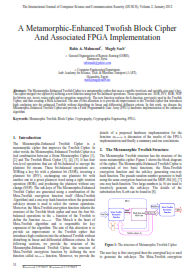
A Metamorphic-Enhanced Twofish Block Cipher
and Associated FPGA Implementation
Rabie A. Mahmoud, Magdy Saeb
January, 2012
Abstract: The Metamorphic-Enhanced Twofish Cipher is a metamorphic cipher that uses a variable word size and variable-size user’s key. The cipher merged two ciphers by defining a new function using four bit-balanced operations. These operations are: XOR, INV, ROR, NOP for bitwise xor, invert, rotate right and no operation respectively. The new function replaces the h-function, previously used in the Twofish Cipher, and thus creating a Meta h-function. The aim of this alteration is to provide an improvement to the Twofish cipher that introduces high confusion into the enhanced Twofish without disturbing its linear and differential diffusion criteria. In this work, we discuss the Metamorphic-Enhanced Twofish Cipher and provide a Field Programmable Gate Array (FPGA) hardware implementation of the enhanced algorithm.
Keywords: Cipher, Metamorphic, Twofish, FPGA, Cryptography, Cryptographic Engineering
Metamorphic-Enhanced_Twofish_Block_Cipher__FPGA_Implementation_IJCSCS
| Volume 1, 2011 |
| Number 7, December 2011:
A Key Distribution Protocol Applying a Haar-like Transform (KDPH) Magdy Saeb December 2011 Abstract: Key distribution is a central cryptographic problem in data communication security. In this work, we present a key distribution protocol employing a Haar-like transform. The shared secret is a number of elements of the reconstructing trend and fluctuations vectors. The protocol security is based on the fact that the reconstructed number of elements of the vector, used to build the secret message, are double the number of the elements constituting the shared secret. This shared secret is updated whenever a new key is generated. The proposed technique uses simple arithmetic operations that provide uncomplicated and efficient software and hardware implementations. Keywords: Key Distribution, Haar Transform, Cryptography, Authentication, Encryption.
|
Number 6, November 2011:
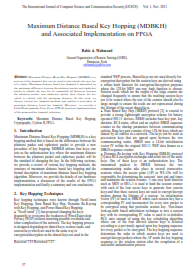
Maximum Distance Based Key Hopping (MDBKH) and Associated Implementation on FPGA
Rabie A. Mahmoud
November 2011
Abstract: Maximum Distance Based Key Hopping (MDBKH) is a process of key hopping that can be used to interchange the user key of a cipher. Maximum distance based key hopping depends on the maximum difference between the plaintext packet and ciphertext packet to change the user key by computing all distances between the plaintext packet and ciphertext packet then choose the key which is related with the maximum distance. In this work, we discuss various key hopping methods and suggest a procedure of maximum distance based key hopping. Moreover, we provide a Field Programmable Gate Array (FPGA) hardware implementation of the proposed key hopping technique.
Keywords: Maximum Distance Based Key Hopping, Cryptography, Cyclone II, FPGA.
Number 5, October 2011:
The Expeditious Cipher (X-cipher): A High Throughput Lightweight Cipher
Magdy Saeb
October 2011
Abstract: Pervasive computing utilizes devices with cost constraints and limited resources in terms of memory, processing speed, and battery supply. Furthermore, we are witnessing the phenomena of halving of the price for constant computing power in less than two years. RFID processes sensitive health-monitoring or biometric data. Accordingly there is a demand for specially-designed cryptographic primitives that are to be efficiently implemented. For these implementations and ciphers that are particularly suited for this purpose, we use the term “lightweight cipher”. The Expeditious Cipher (X-cipher) is a high throughput light-weight cipher with relatively simple design and hardware implementation. In this article, we discuss the cipher design rationale, its software and hardware implementations. The cipher security is based on the well-studied SHA-512 and Whirlpool 512 hash functions that are used to generate the cipher sub-keys. We appreciably enhance the cipher security by cascading the two hashes in a pseudo random manner that is user-key-dependent. The cipher employs a variable-size user key and we show that the encryption rate for its associated hardware implementation reaches 512 bits per cycle. The block size can be varied using other types of hash functions.
Keywords: Cipher , Encryption, Lightweight, Hash function.
Number 4, September 2011:
Performance Evaluation of 802.11p and WiMax over Resource Data and Penetration Rate Changes
A.M.Kenawy, M.E.Nasr, M.Saeb, Kh.Shennawy
September 2011
Abstract: Two of the most commanly used wireless technologies mobile WiMAX, based on IEEE 802.16e standard and the 5.9 GHz technology based on the IEEE 802.11p standard, are studied and compared. The potential and limitations of both technologies as a communication media for Vehicle to infrastructure Networks V2I are simulated. The obtained results show the performance of the two systems evaluated for different Vehicle Penetration Rate VPR, Source Data Rate SDR, and network deployments.
Keywords: ITS, ITT, IEEE 802.11p, 5.9 GHz tech
Number 3, July 2011:
Haar Wavelet Transform of The Signal Representation of DNA Sequences
Mohamed El-Zanaty, Magdy Saeb, A. Baith Mohamed, Shawkat K. Guirguis
July 2011
Abstract: Complex sequences of DNA nucleotides and their associated search techniques can be relatively simplified when presented as a digital signal. This approach applies known signal processing techniques for the analysis of genomic information. We present a set of tools for the signal representation and analysis of genomic information. In this work, we provide a matrix and a sparse polynomial representation of the DNA. We show that sparse polynomial representation of the DNA sequences improves the search performance and reduces the storage requirements. The DNA nucleotides are presented using the compact form similar to QR (Quick Response) representation that offers a broad scope of practical usage. In addition, we speed up the search process by applying the Haar Wavelet technique on the resulting DNA signals. Based on multi-level Haar transform, the search starts at the n-th trend and follow the various levels upward until a match is found. Some important features of nucleotide sequences are revealed using these visual signal representations by comparing members of the same evolutionary family.
Keywords: DNA, Signal Analysis, Haar Wavelet, Multi-resolution Analysis, Sparse Polynomial, Quick Response.
Number 2, June 2011:
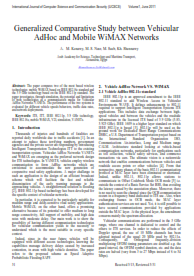
A. M. Kenawy, M. S. Nasr, M. Saeb, Kh. Shennawy,
June 2011
Abstract: The paper compares two of the most frequently used wireless technologies: mobile WiMAX based on IEEE 802.16e standard and the 5.9 GHz technology based on the IEEE 802.11p standard. The paper investigates, through simulation, the potential and limitations of both technologies as a communication media for Vehicular AdHoc Networks VANETs. The performance of the two systems is evaluated for different vehicle speeds behaviors; traffic data rates and network deployments.
Number 1, April 2011:
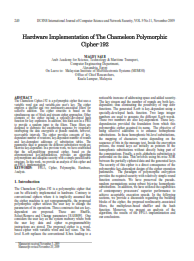
Magdy Saeb
Novemeber 2009
Abstract: The Chameleon Cipher-192 is a polymorphic cipher that uses a variable word size and variable-size user’s key. The cipher employs a shuffler and two nonlinearity-associated filters for selective addition. The cipher structure is based on the simultaneous use of block and stream cipher approaches. Other elements of the cipher include a specially-developed hash function for key expansion. In addition, this hash acts as a PRG to provide a random input to the filters. These filters are designed to elaborate the enciphering sequence by irregularly interrupting the data encryption at pseudo random, however, recoverable intervals. The cipher provides concepts of keydependent number of rotations, key-dependent number of rounds and key-dependent addresses of substitution tables. The parameters used to generate the different substitution words are likewise key-dependent. In a previous work, we have established that the self-modifying proposed cipher, based on the aforementioned key-dependencies, provides an algorithm polymorphism and adequate security with a simple parallelizable structure. In this work, we provide an analysis of this cipher and an FPGA implementation.
Keywords: FPGA, Cipher, Polymorphic, Hardware
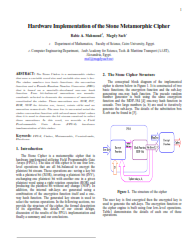
Hardware Implementation of the Stone Metamorphic Cipher
Rabie Mahmoud, Magdy Saeb
January 2010
Abstract: The Stone Cipher is a metamorphic cipher that uses a variable word size and variable-size user’s key. The cipher employs two basic functions; the encryption function and a Pseudo Random Number Generator (PRG) that is based on a specially-developed one-way hash function. Four bit-balanced operations are pseudorandomly selected to generate the sequence of operations constituting the cipher. These operations are: XOR, INV, ROR, NOP for bitwise xor, invert, rotate right and no operation respectively. The user key is encrypted using the cipher encryption function with agreed-upon initial values then it is used to generate the bit stream required to select these operations. In this work, we provide a Field Programmable Gate Array (FPGA) hardware implementation of this cipher.
Keywords: FPGA, Cipher, Metamorphic, Cryptography, Hardware.

